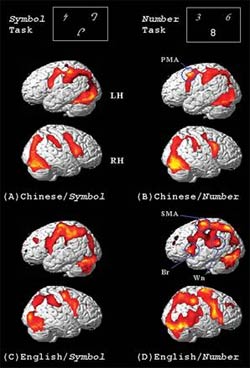The thinking processes of native English speakers differ significantly from those of native Chinese speakers. Both groups can easily solve arithmetic problems, yet they utilize different areas of the brain.
 |
|
MRI scans showing brain regions lighting up when native Chinese (top two rows) and native English (bottom two rows) speakers perform tasks related to symbols (left column) and numbers (right column). Image PNAS |
A research team used brain imaging to identify which areas of the brain are activated when individuals perform simple calculations, such as 3 plus 4 equals 7. All participants utilized the Arabic numeral system, which is prevalent in both cultures: English and Chinese.
Both groups activated a region of the brain known as the inferior parietal lobule, associated with reading and visualizing quantities.
However, while native English speakers displayed additional activity in language processing areas, native Chinese speakers engaged another brain region for visual information processing.
This difference “may suggest that Chinese speakers approach problems in a fundamentally different way compared to English speakers,” said Yiyuan Tang, the lead researcher from Dalian University of Technology in Dalian, China.
“We believe that language plays a crucial role in mathematical processing,” Tang stated. However, he added that cultural factors may also play a role, such as mathematical learning strategies and teaching methods in schools.
These cultural differences could aid scientists in developing optimal strategies for mathematical problem-solving, Tang explained. “There may be certain strategies that are more effective, even when used with different languages,” he mentioned.
Richard Nisbett, co-director of the Culture and Cognition Program at the University of Michigan in the United States, who did not participate in the study, remarked: “This work is important because it tells us about the specific pathways in the brain that underlie some differences between Asians and Westerners in their thinking processes.”
Last year, Nisbett found differences in how Asians and North Americans perceive images. He tracked eye movements and discovered that when observing a painting, North American students focused more on the prominent objects in the foreground, while Chinese students spent more time examining the background and considering the whole scene.
“Literally, they observe the world in different ways,” he stated.
T. An


















































